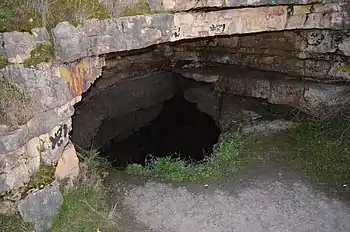Hotu and Kamarband Caves
The Hotu and Kamarband Caves or Belt Caves are prehistoric archaeological sites in Iran. They are located 100 m (330 ft) apart, in a cliff on the slopes of the Alborz mountains in the village of Toroujen (currently called Shahid Abad), 5 km (3.1 mi) south west of Behshahr in the Mazandaran province.
| Part of a series on the History of Tabaristan |
|---|
 |
|
|
Excavations took place led by Carleton S. Coon and were reported on between 1949 and 1957.

Hotu Cave has an approximate size of 30 m × 20 m (98.4 ft × 65.6 ft). The site produced pottery shards, stone tools and material that could be radio-carbon dated. Twenty-two samples were dated and attributed to eight different cultures. The 2 earliest cultures, present at around 9,910 to 7,240 years BCE are assumed to be seal hunters and vole eaters. The bones of a dog have been cited as an example of exceptionally early animal domestication.[1] Pre-Neolithic finds date to around 6,120 years BCE.
Kamarband cave is notable for three human skeletons discovered there, dating to approximately 9,000 years BCE. Other finds include flint blades, walrus and deer bones, giving valuable information about human development from the ice age in the Mazandaran area.[2]
At Hotu Cave dwellers were identified as having Y-chromosome haplogroup J (xJ2a1b3, J2b2a1a1), with a more refined analysis putting it at J2a-PF5008*.[3][4][5]
Literature
- C. S. Coon, Cave Explorations in Iran 1949, Museum Monographs, The University Museum, University of Pennsylvania, Philadelphia, 1951.
- C. S. Coon, "Excavations in Huto Cave, Iran, 1951: A Preliminary Report", Proceedings of the American Philosophical Society; 96, 1952, pp. 231–69.
- C. S. Coon, The Seven Caves: Archaeological Explorations in the Middle East, New York, 1957.
References
- Animal Domestication in the Prehistoric Middle East by Charles A. Reed
- GAR - Encyclopaedia Iranica
- Iosif Lazaridis et al. The genetic structure of the world's first farmers, 2016.
- First ancient J2 from Iran (Mesolithic, Copper Age) and Levant (Bronze Age) – Lazaridis et al. first farmers
- "The History of J2 - Page 6".